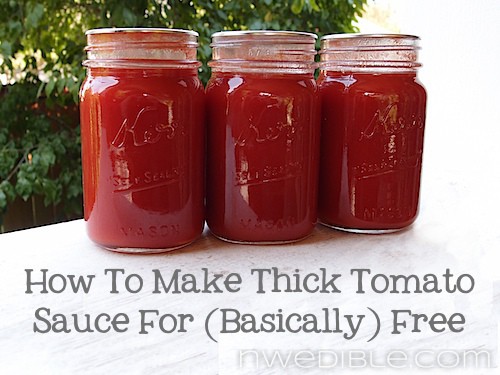
It has come to my attention that many people are unwittingly throwing away free tomato sauce when they preserve their summer tomatoes.
Here’s the thing: like all fruit, the skin of tomato is where much of the natural pectin resides. Pectin is the starch that gives jams their thickness and good tomato sauce its natural, noodle-coating thickness.
But tomato skins in a canned tomato product can be tough and stringy, and do that thing where they stick between your teeth and make you feel like you are getting a floss job from Satan’s dentist. This is why almost every canned tomato recipe calls for the initial step of coring, blanching and skinning tomatoes.
When you are working with 50 or 150 pounds of tomatoes at a time, those cores and skins really add up. If you are just chucking them to the chickens you are missing the opportunity to make really excellent – and essentially free – thick, smooth tomato sauce.
The Secret Ingredient is “Free”
Here’s what you do to turn all those “waste”skins into top-quality, pectin-rich, thick tomato sauce.
Sort tomatoes. Any that are showing signs of rot, mold or disease just chuck.
Wash all your perfect canning tomatoes. I wash my tomatoes in my previously-sanitized sink and add a small splash of bleach to the water. I do this because I will be saucing the skins and I want to cut down on any contaminants on them, but you can decide for yourself if you want to take this step, or perhaps substitute a good quantity of vinegar for the bleach. Because my tomatoes are locally hand-harvested they tend to be pretty clean, but I keep an eye out for any patches of dirt or pieces of tomato leaf and gently scrub these areas clean if necessary.
Rinse, dry and core tomatoes. Save those cores.
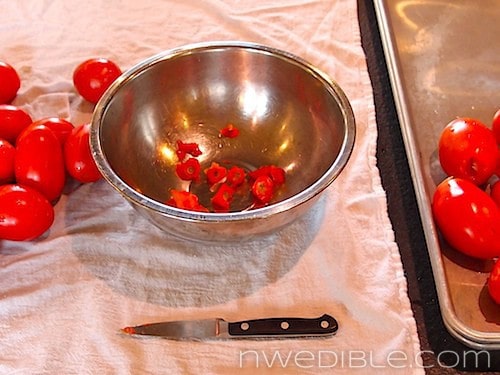
Because I’m right-handed, whenever possible I move from left-to-right when preparing produce for processing. I find this to be most efficient.
Blanch and slip the skins of the tomatoes. Save those skins.
Proceed to do whatever you were going to do anyway with all your peeled tomatoes. Save any extra juice or seeds from additional prep of the tomatoes.
Put all the clean cores, skins, juice and seeds you set aside in a big pot and start simmering. You can’t overcook this, but you can scorch it, so keep the heat on medium and give it a good stir every few minutes.
When everything in the pot is falling-apart tender, say after an hour or more of cooking, and you have a good break where you can attend to your sauce (the 85 minutes while whole peeled tomatoes process in a boiling water bath is an excellent time), puree the contents of the pot. The absolute easiest way to do this is with an immersion blender.
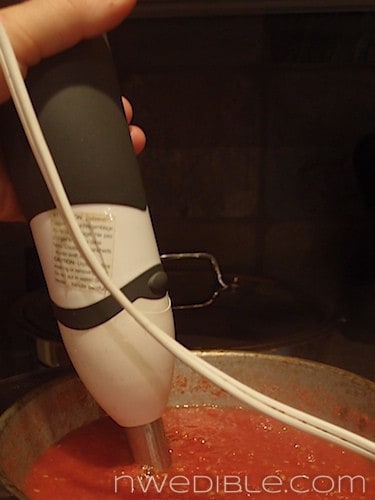
An immersion blender is the simplest, safest way to turn something hot and chunky into something hot and smooth.
Alternatively, you can let the mixture cool a bit and puree it in batches in a blender or food processor. Just a warning: hot liquids + blender = tomato sauce on the ceiling and scalded cook if you aren’t careful. Do a Google search on how to blend hot liquids before you go this route. (After which you will probably decide to take my advice and just go buy an immersion blender.)
When your sauce is smooth-ish, work it through a fine-mesh strainer or chinoise. Use a small ladle or spatula to push all the thick pulp through the strainer while leaving the now straw-like skins behind. Really go for it at this point – you don’t want to leave anything but dry skins and seeds in that strainer.
I strain my sauce directly into a second, clean stockpot. If all my large pots are in use, I strain into a large bowl, clean the original stockpot of any stuck-on tomato peels, and pour the finished stock back in.
Return your sauce to the heat and reduce until it is at your desired consistency. Season to taste with salt and, if desired, proceed to preserve by canning or freezing.
Remember, tomato sauce requires the addition of 1 tbsp of bottled lemon juice or ½ tsp citric acid per pint to be safely water bath canned. Here’s info on safe acidification practices for tomato products. Pints require 35 minutes of processing in a boiling water bath at sea level. Here’s additional information on safe ways to process tomato sauce.
Is It Worth It?
If you’ve never done this, you will probably be surprised at how much sauce you get from what you would have normally just thrown away.
These are the sauce yields from three separate tomato-processing events this summer:
Batch one: 150 pound of Roma tomatoes yielded 17 pints of thick, skin-based tomato sauce
Batch two: 40 pounds of Romas yielded 5 pints of thick, skin-based tomato sauce
Batch three: 50 pounds of Romas yielded 9 pints of thick, skin-based tomato sauce
So, depending on how much flesh clings to the skin of your tomatoes when you peel them and how much you reduce your stock, I’d estimate you will get 1 pint of finished sauce for every 6 to 9 pounds of canning tomatoes you peel and core.
This is a great way to eek as much possible goodness out of your harvest or hard-purchased tomatoes. From 90 total pounds of raw canning tomatoes, using this method to recapture sauce from the skins led to a total amount of composted waste of less than 3-and-a-quarter pounds. That’s a processing loss rate of about 3.5% which is, in my opinion, excellent.
If you are canning 50 pounds of tomatoes or more, you will definitely have enough skins to make this process worthwhile. If you work in smaller batches, you might consider saving all your cores and peels in the freezer until you have accumulated enough to make this food reclamation process make sense. The freezing of the peels will not noticeably impact the final texture of the sauce.
Free tomato sauce! And you don’t even have to dumpster dive to get it.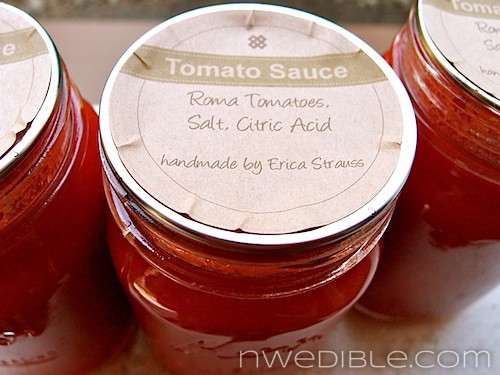
Not-Free Stuff That Helps A Lot When You Are Making Free Tomato Sauce:
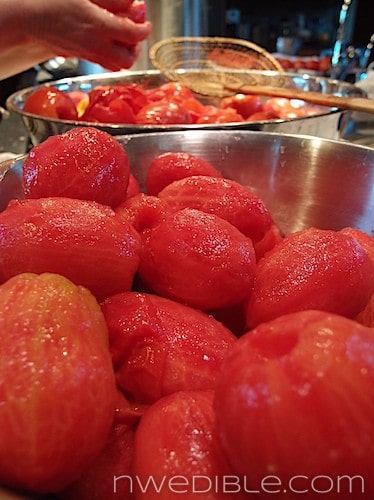


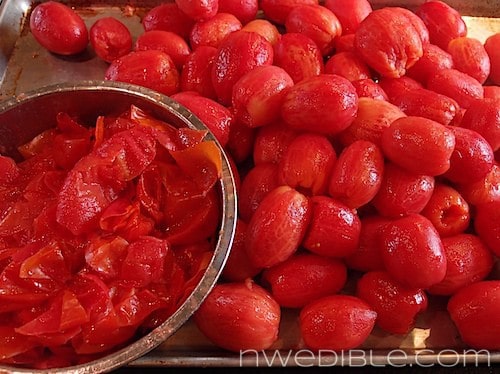
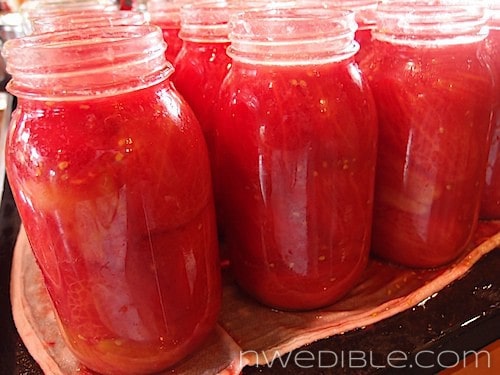
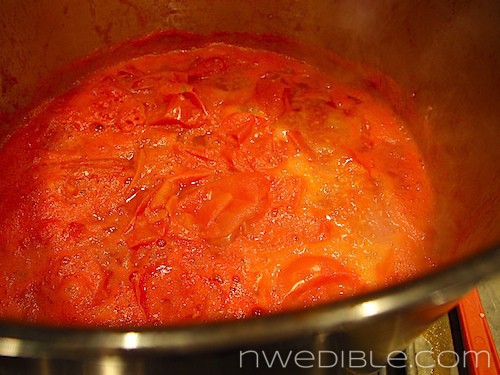
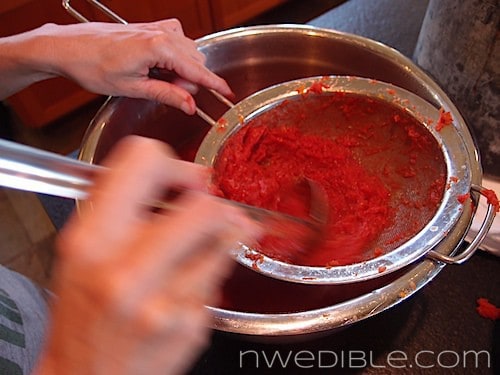
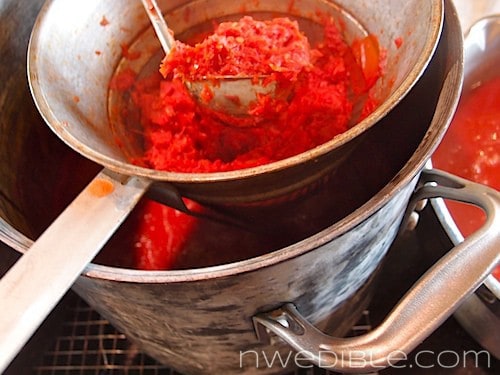

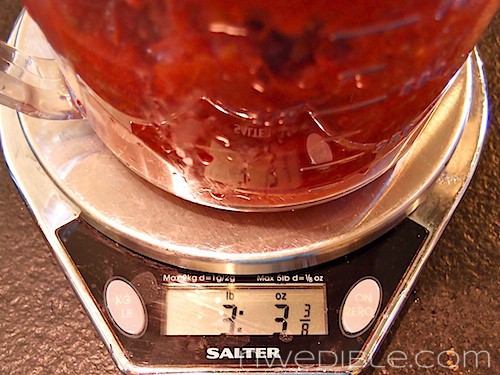



Glad to see the praises of an immersion blender for this purpose. They really are almost the greatest thing since sliced bread and IMHO are the only way to go when making smoothies. (A wide-mouth, pint canning jar takes the blender perfectly.)
I also process the tomato trims, as so much of the nutritional value of fruits and veggies is in or just under the skins. My tom’s are grown plenty clean enough to not let these beauties get by me. Thanks for the added-value post today.
An after-thought: Before I peel mine (when I do…), sometimes I put some of the clean, dry, whole tomatoes on oiled medium-hot grill for a few minutes, allowing them to roast just a little (may even have a few grill marks on them, just try not to let them burst – be ready to take them off into a bowl if this happens). Then continue cooking and processing them as normal – fire-roasted flavor for part of the batch.
Salsa! Fire roasted salsa! Yum, yum, yum (and on my list for next weekend, actually). 🙂
I do love my immersion blender! I have had a few and have always had the best luck with the moderately-priced (like $30) type blenders. My first one was $20 from the drug store and lasted years – 6 or 7 at least. My second was a very fancy cordless immersion blender from a very fancy kitchen store. $100 (maybe more!) and it died on me after only a year or so of use! 🙁 Now I’m back to the basic kind and it’s going strong. Couldn’t make half of what I cook without it.
I LOVE my immersion blender! I don’t remember if I got it when I moved into my own apartment, or after I got married. Either way, it’s about 25 years old and still going strong! (I just hope I didn’t just jinx myself by saying that!)
My 75 yr old Dad and his partner also process peach skin and pits into amazing peach pit jelly. Gorgeous tasting stuff-great color.
That sounds amazing! Can you share the process?
Much appreciated!
Basically, you save the peels and skins from the peaches you can (you can use just skins if you want, but the color is much better with the pits). Then put the pits/skins in a pot with just enough water to cover and boil until the water changes to that pretty peach color. You can’t over cook it. Strain the peach juice. Use juice in any basic jelly recipe.
I to make peach jelly by cooking my skins and pits. This year I made peach sauce (much like apple sauce) by peeling, pitting, and cutting up my peaches. I took the cut up peaches and added just enough water to cover. After they had cooked to a really soft stage I drained the peach water into a clean stock pot and sat it aside. I took the peaches and ran them through my food processor until they were smooth. I took this an added fruit fresh, sugar (to taste) and cinnamon and then cooked them to reduce some of the liquid . Then packed them in jars and water bathed for about 15 minutes.
Then I took the water that I had cooked the peaches in and heated it up added a little sugar reheated it packed it in quart jars and make peach juice for drinking. My husband loved it. You could also use this to make jelly out of.
My grandma taught me how to make peach-pit jelly. Using the scraps makes canning go from a fun hobby to actually profitable. So happy to have a way to use my tomato scraps!
I only make sauce and so puree the whole tomato (minus the core) in my Cuisinart and then dump the liquified tomato into a huge cauldron and cook it down. I used to peel them, but why since I’m not canning whole tomatoes.
BTW, if you’ve got plenty of freezer space you can freeze your paste tomatoes whole in gallon sized bags, and when they thaw the skins slip off easily. Great for throwing into chili come winter.
I’m trying this now with 50# of tomatoes I couldn’t quite get to in the freezer. Looking forward to seeing how it goes!
Man, I am so glad to read this. I expect to be canning up a storm on Friday, about 20 – 50 lbs of tomatoes, and it would have pained me to toss all those skins. I’m glad there’s something more that can be done with them! Though, probably, I will freeze the skins until another day to deal with them later.
I was recently making a tomato puree for a cocktail, and noticed how much more I got out of the skins the second time around than the first, and how dry the skins & seeds looked. Now I’m extra glad I worked so hard at it, so I know what to look for here.
Thanks again.
Good timing! 🙂 If you read the comments here it sounds like there are a lot of ways to eek all the goodness from your ‘maters so you can see what makes the most sense for how you cook.
This post comes a day or too late for me. We made 50 lbs of tomatoes into sauce on Saturday, though my Blendtec blender is strong enough that we only cut out the cores and bad bits – the skin stays in. The skins from the 25 lbs we canned as chopped tomatoes and salsa on Sunday spent the night in the dehydrator for tomato powder. However, there were only a bit more than 2 pints of skins, so I’m guessing we would have had a lot less sauce than your estimates.
I’ve got one 25lb box of tomatoes left for smaller batch projects, so I’ll have to try this with the skins from those.
Now I wish I had flipped the dry skins (after saucing) into the dehydrator. That will be my next tomato-processing food-salvage project. Yeah, I honestly don’t know how it happens, but what looks like a small or medium bowl of skins becomes a dozen pints of sauce. It’s kinda like magic, honestly.
That’s what we do if we are canning whole tomatoes. The dehydrated tomato skin powder is great for so many things! Otherwise, we go with the method Rachel and Elizabeth use, cooking it all down and using the food mill for sauce.
This is pretty awesome. We just quarter our tomatoes, boil them down a bit and then use a food mill to remove the seeds and stiff skins. We usually end up with very little waste this way so I think we’re just doing this but in a roundabout way and it ends up just mixed in with our normal batch.
I think the end result is the same from a waste perspective as long as you like a smooth sauce for all your tomatoes. I really like chunky crushed or whole tomatoes for making chili in the winter with big pieces in it, but I think next time I can I will try using my food mill. It might make the whole process faster.
Rachel, we must have been writing our response same time! Sounds like we do basically the same thing. I end up with a consistency about half way between juice and sauce.
I core, put the core in compost, quarter and put tomatoes in kettles filled up to top. Simmer till broken down. Do not peel. Stir frequently . When cool put through food mill to take out seeds and skins. This can be stored in fridge until ready to can. When have enough to do canner full reheat to boiling and then follow directions in canning guide. I use BALL BLUE BOOK. I gave up on whole tomatoes years ago. I do at least 45 quarts this way, 50 or more if a good year. That allows me at least 1 quart a week for cold weather food like soup base, chili , rice dishes , enchilada sauce, spaghetti sauce etc during the fall and winter and into spring. Do not use much in warmer months. Also share with daughter.
Only time I slip skins on tomatoes is for canned salsa. Fresh salsa I leave the skins on.
Similar to what Rachel is doing (comment above yours). I think this is a great method, and I love how it allows you to batch everything. We really like chunky whole or just-crushed tomatoes in our soups, stews and chili so slipping skins will be in my future for a while I suspect. 🙂
Yeah, I have one child who is of the ilk that chunky is yucky. She is the youngest and so that kind of put an end to anything chunky in sauces etc. She is still like that, the youngest, 22 and still lives at home. An example, I was sauteeing up mushrooms, zucchini, onions, and I though they was pretty finely diced. I was going to add them to the spaghetti sauce. She looked into the fry pan and exclaimed what is this disgusting looking stuff! The other children have no chunk phobia.
Due to her pickiness she may or may not find she has a meal. If it looks too gross to her she has to resort to hummus and bagels.
Homebrew Husband was late to the “food with pieces” game too, but now he’s as open and non-judgmental about food as anyone. Sometimes it’s easier to accomodate, but do you ever just want to say something like, “here honey, I got you a blender for Christmas. Feel free to put your dinner in it before you eat. The rest of us will be having our big disgusting mushroom chunks at the table.”? 😉
I was a no-chunks person until I decided at age 20 that I needed to learn to deal wit chunks so I started with finely chopped and worked my way up gradually to full size pieces. I found slimy chunks (like tomatoes) the hardest to work up to. I’m hoping my own experiences will grant me patience if any of my kids are finicky. I know I have trouble when my kid brother makes faces at the food. I’m always tempted to say something snarky. 🙂
Eat what I make or go hungry. You do not give into “phobias” unless there is some physical reason for it. Otherwise, you end up with a 22 year old still living at home and telling you how to cook and making more work for YOU! If SHE wants to do the extra work, then fine, but otherwise, NO WAY.
If this is response to me, if you read my response you would see that my 22 year old still living at home has to find her own meal if she does not like what is served.
Oh, and she is living at home as she is in college (we have state university here) and she has multiple disabilities. It is easier for everyone all around.
That comment is out of place and inappropriate.
Can’t remember which post brought me here but I’ve read through jams, sorbets and now I’m in tomatoes. I still have to get off the couch and see if my blender blade fits a canning jar (I’m really late to that party, but I’m seriously doubting that it would be save with frozen fruit chucks or ice cubes (?)). As far as tomatoes go I agree with the food mill advocates here. I’d never heard of one, but received it as a wedding present and now 18 years later I can’t imagine preserving without it. In addition to apple/pear sauce it works for berries (I’m going to make your berry sorbet with the thawed marion berries in the fridge today) and also tomatoes. If you just want chucks for winter meals I’d cut up what you want and freeze them flat in freezer bags. You can break off exactly what you need for that pot of chili, etc. I do the same with herbs and lemon/lime juices rather than trying to freeze, bag and store those things in ice cube trays first.
We went this way: Cut all the outer bits away, about 3/8 unch thick, leaving a pile of “peelings sitting next to a naked tomato. The pile goes into the solar dehydrator, peeling side down; the naked bit goes in the stocpot, with onions and spices, for a cookdown. The “peelings” are the most popular — taste like bacon bits. But the canned product seems to be useful across the board. We use it to make salsa, sauce, or puree as needed. I’m gonna star this post in my reader, though. An excellent system, beautifully documented and taught.
Thanks! Do you use a potato-peeled type tool to peel your naked tomato, then? I loving the idea of the dried tomato skins in various forms. I am going to try that on my next batch for sure.
Great idea! Thank you! Just loving your blog lately. 🙂
Last summer I learned of roasting my halved tomatoes instead of cooking them in a stockpot. 350-400 degrees until soft and fragrant, then into the Vitamix. When thoroughly blended (it even purées the skins and disintegrates the seeds) the sauce can be brought to a boil on the stovetop and canned. I have also strained the sauce through cheesecloth to get a thicker paste as well as tomato juice. I have added onions, celery, beets, carrots, etc to the tomato juice to make veggie juice (straining out the veggies after simmering for an hour or more.) I think I pressure canned the juice because of the non-acidic additions. I also broil my red salsa and salsa verde vegetable ingredients, stirring every 10-15 minutes, until slightly blackened and fragrant, before blending and adding lime juice and salt. I use Linda Ziedrich’s recipes. Family Favorites!
I tend to at least take out the seeds, as I had heard it can leave a slight bitter taste in the sauce…any truth to this?
Lady Banksia, I find the tomato seeds do add some bitterness, so I usually make a separate batch with the seeds in, depending on what I’m putting the sauce in I may care more or less.
Oh man – this is brilliant!
Great idea! I’ve been using my skins and cores in veg broth, so they weren’t going completely unused–but I think making actual sauce out of them is a much better idea.
Another vote for the tomato powder with skins, but never thought of this for cores. Next batch I will try it, though I have skins in the oven right now. : )
I have an even lazier way to make thick sauce. I throw the washed, raw tomatoes in a puree attachment that goes on my mixer and put the skin/seed sludge the puree gizmo spits out back through a couple times until it’s pretty dry and nearly nothing. Then, I let the entire puree set for half an hour or so, and it separates into a nearly clear pink liquid and a thicker sauce. I separate it and save the clear stuff – I freeze it because laziness is my way – and it makes fabulous liquid for soups. The thick stuff is simply that – thick stuff. I cook it a bit with my seasoning, but no long standing over the hot stove and stirring (and scorching when I forget to stir). Ya know the taste of Campbell’s alphabet soup that is like no other, like the yumminess of childhood? That’s what soup made with the clear stuff tastes like. Sometimes my puree doesn’t separate. I go at it with a stick blender for a couple minutes and for some reason that helps the separation to occur.
With all this discussion about drying tomato skins for powder, makes me wonder if there are any other fruits that I could do this with and have it be worthwhile? I’m thinking the ‘fruit-skin powder’ of say, maybe cherries, would be a good stir-in for yogurt or when making ice cream for a flavor boost…or ‘apple-peel powder’ to add back into homemade pie filling or applesauce? Probably ought to consider the use of organic items, though…but that might make it almost cost-prohibitive.
I go at the tomato canning a bit differently, but it still ends up being a no-waste process. I cut whole, unpeeled tomatoes of any variety into large chunks and throw the pieces into large roasting pans. Roast them down in a 400-450 oven for 30-45 minutes. They will throw off a lot of water – and this is water you’d otherwise end up canning when you can whole tomatoes (why can water?) or cooking out for hours in a saucepot. (You can also do the roasting on a grill if you don’t want to heat up the house by turning the oven on.) I scoop the tomato pieces out of the juices and into jars, add a bit of lemon juice or vinegar, and this is what I WB can. Throw the canned product in a food processer for a few pulses, and it’s smooth as can be. And I never throw away those leftover roasted tomato juices…they make a fabulous “poor-man’s V-8,” I use it in place of water to make rice, couscous, or other grains, add to soups & stocks, the list goes on & on.
Great idea, I will try this when I do my tomatoes again this year. Did a lot of pasta sauce. I am in South Australia. I used my thermomix to cook my sauce and puree it. I know you guys cant buy them in US but they sell them in Canada. Google thermomix.com and check this kitchen appliance out. Its the most fantastic machine. Saves lots of time and money making your own food from scratch. Presertive free cooking.
Fantastic! I have never canned tomatoes but I plan on making it a priority next year. Most of the recipes I found just tossed the skins and cores.
Brilliant post, and brilliant timing! I just bought 20 lbs of tomatoes and want to make pasta sauce with it, tomato sauce comes first! You’re the best!
Another lovely use for tomato skins – thanks Erica 🙂 Last week I dried my own leftover tomato skins and then pulsed them into a fine powder. The resulting Tomato Powder is absolutely delicious and will be great for deep tomato flavouring of dishes like goulash, spaghetti and other pasta dishes.
I have a tomato jam recipe (from Marisa at food in jars) that uses the whole tomato including skin and seeds. So when I can other tomato products, I save whatever skin and seeds are leftover to make the jam. The basic tomato jam recipe calls for 5 lbs of tomatoes so I use the skins/seeds from 2 1/2 to 3 lbs of tomatoes along with 2-3 lbs of whole tomatoes to make the jam.
I’ll have to try the dehydrating technique described above. I can in pretty small batches to make sauce from the skin but I’ll keep it in mind.
I love this! Thanks so much for sharing. I feel so wasteful now for chucking all my tomato skins before.
I totally love your blog and as a gardener in the Pac NW we be back for more!
So could you then pull this out, make a nice cream based roux and make tomato soup? Thinking that my tomato soup recipe base is pretty similar…
Yes, absolutely. And if you swing this way, you can add some dill too. A nice dilly tomato bisque makes me swoon. I skip the roux and just do a dash of heavy cream but you can thicken as much as you like of course.
oh good idea on the cream. I will try that. Thanks!
Thanks so much for the idea. We just made tomato sauce from 25lbs of farm fresh tomatoes and it was great not to waste any part of them.
Thanks for the post and Homestead Survival leading me to you. I threw away skins last week because I just wasn’t sure how to process them. Which I had simple frozen them. Boy tomorrow I am doing 55 lbs of tomates and will totally use the skins.
After finding your blog and this post, I found a localish farm selling tomatoes at 60 cents a pound. Sixty pounds later, my freezer is loaded with tomatoes and I made about 48+ oz of sauce from the skins. A recipe from A Year of Inconvenience blog did the trick, and we were in spaghetti heaven! Thanks so much for a smart use of a usually-wasted product.
Erica, thats a great idea i saved a couple big bags of tomato skins and cores and froze them cause a friend told me they make good tomato juice, borrowed a juicer… lets just say that you get what you pay for with juicers. Next year i will invest in a good juicer but for now i can thaw out the skins i have and use your method i should get at least 2 qts out of what i have. I have a ? for you that is unrelated to tomatos. Do you know if potted meats can be water bath canned? I would think the fat in duck confit would be enough to keep it safe if it had air tight seal but i am not sure. If not i will probably just put the confit in pint jars and freeze it. Also a small tip maybe not as usefull for your larger family but with just 3 to feed i find it usefull to freeze pesto in ice cube trays, 1 to 2 cubes per person seems to b a perfect portion, then u just put the cubes in qt freezer bags.
Thank you for the fabulous idea/recipe for utilzing all the tomato goodness! I thunked myself on the head and said, “Why didn’t I think of that!?” Especially since I already do practically the same thing with my apple harvest. I save all the peels and cores (minus any bruised or rotten ones) throw ’em in my stockpot and add water just to cover and simmer for hours till it is all mushy. Then I use my immersion blender, strain and with the juice/pulp make apple jam practically FOR FREE!hopping around your blog, great job!
Really have enjoyed
We too roast all of our tomatoes – and as growers with thousands of heirloom tomato plants we have loads of seconds. Our method is to fill roasting pans with cored, quartered tomatoes (peels left on), add other veggies if available – peppers, eggplant, zucchini, onions, big handfuls of fresh herbs , (maybe a little wine) etc and roast at 350 degrees most of the day. If we are passing through the house (we are in the field all day) we give it a quick stir. By the end of the day the sauce is dark, thick and very rich. We cool it and put it into zip-locks. They stack well in the freezer. The sauce is used as a base for soup (blend and add some cream), pasta sauce, pizza sauce and more.
Don’t use the puree attachment, you lose the thickening and flavor from the skins. If not canning whole blend the lot first and with luck the skins will blend and the seeds won’t. Then strain.
Don’t ‘settle out’ the liquids, they have a lot of flavor. Maybe settle out and then just boil down liquids then add solids and boil to suit.
Don’t throw anything out! Fry the last mortal remains in hot oil and toss ’em into your next batch of stock. Loverly rich flavors.
This is such a great idea! Last year, not wanting the waste, I dried the peels on a wire rack in my oven for hours until crispy. Then once completely dry and crispy, I blitzed them in the FP until they became a powder. I now add that to sauces for an added t’mater punch. But I love this idea too as it wastes even less!!
KK
I’m curious as to why you don’t just use a food mill? Then you don’t have to core OR peel your tomatoes at all.
Great idea! I am looking forward to trying this soon!
On another note…where did you get those great can labels? I am always looking forward to new labels!
Thanks!
Check it out here! https://nwedible.com/2012/08/how-to-martha-up-your-jam-labels-for-nearly-free-in-about-5-minutes.html
Just made this tonight! Awesome. I did as you suggested and froze the bits until I had enough. Love eeking out every last morsel of goodness from these summer beauties.
Why couldn’t I have found this two days ago! Just canned 10 lbs and could have thrown the skins in the freezer until I had enough!
I recently moved back to the Pacific Northwest (should have come home sooner 🙂 )
my deeply saught after question is this:
Where do you get the produce from in such large quantities? is it cost effective? trying to save money for our newly single income family 🙂
I am new to canning and just started canning this year. I am so glad I found your post BEFORE I started canning anything. I have probably canned well over 100lbs of tomatoes so far this summer and I have 6 gallon sized ziploc bags full of skins, cores, and juice from my tomatoes to boil down for sauce (whenever I get around to it). I am excited to be able to use up all those goodies. I am thinking it will be a good cool fall day project once I get all my tomatoes canned.
Thank you for this! I featured you today over at Creative Green Living
Wow, thanks for posting this! I have always hated just throwing away the skins and cores after making salsa and such. I tried this just as you stated and it worked awesome!! The only thing I did different was use a foley mill to remove the seeds and skins, which worked awesome! Yum, this stuff is delicious!! Thank you!!! 😀
I’m working through canning crushed tomatoes, and I want to make suace with the skins and cores… but the tomatoes I’m using are about the size of my face, and the cores I’m cutting out are pretty gnarly- huge, kinda woody, some split skins (overwatering?) that scarred over, etc. Would you toss them in with the skins for sauce since you end up immersion blending them all together later? Or would the straining step catch any gunkiness?
Thanks for any input!